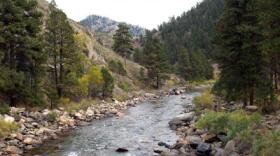Wildfire forecasters say Northern Colorado’s fire season should be far less active than last year. That doesn’t mean they’re resting on their laurels though.
Federal, State and Local officials are still dealing with the after effects of last year’s High Park Fire.
Ash, soot, and sediment continue to flow into the Poudre River past Hewlet Gulch Trailhead 10 miles west of Fort Collins. Jon Halverson, of the U.S. Forest Servicesays on top of the normal sedimentation that occurs during spring snow melt, the effects of the High Park Fire still remain.
“The water is substantially murkier then it would be in a normal year then it was this time last year,” said Halverson.
Further complicating matters is a lack of vegetation that was burned away by the fire. Without groundcover, there’s nothing to stop the ash and soot from flowing into the river after a spring rain storm.
That’s why the U.S. Forest service is hard at work mitigating the fire’s effects on steep barren and gray hillsides. The agency plans to drop thousands of pounds of straw over the most severely burned areas. That should help the soil retain moisture, prevent run-off, and foster revegitation.
Aerial mulching will continue through the end of June.
http://youtu.be/R97jZaLxnSM
Much of the work being performed on federal lands is being paid for through funding set aside for Burned Area Emergency Response.
While the mitigation work needed to be done as soon as possible, Halverson says the slow start to the fire season has helped a great deal. “There’s moisture in the soil that we can help to maintain by getting some mulch and ground cover on it,” he says. “Another thing is, [the] helicopter is available. If the fire season had gotten rolling earlier, [it] may have been committed earlier on active assignments on active wildfires.”
There were fears at the beginning of April that Colorado was heading down a similar path to 2012 with low snowpack and dry conditions. Late season snows went a long way at least in the northern part of the state. But Rocky Mountain Area Coordination Center fire meteorologist Tim Mathewson says northern Colorado isn’t out of the woods by any means.

“Just because we’re wet right now-we’ve been wet this spring so far, doesn’t eliminate fire season in Colorado,” said Mathewson. “So, right now we’re thinking it’s going to be geared toward an average fire season. Which does mean that we will still see fires and some large fires.”
According to Paul Cooke, director of the Colorado Division of Fire Prevention and Control, the delayed start to fire season has been very good for state firefighters.
“It’s provided us more time to do exercises with our federal partners and other state agencies to make sure we’re ready for that,” said Cooke. “We’re going to work on it this year during fire season and see how it works. And you know, like last year we had a fire-season that didn’t end. So we hope that we don’t see that again.”
The reprieve in wildfires has allowed the volunteer firefighters of the Rist Canyon Fire Department to continue their preparations for the upcoming season. Several homes were lost in Rist Canyon during the High Park Fire including those of volunteer firefighters.
Bob Gann, chief of the department, says while the moisture of the last several weeks has help to lessen the fire danger, he has something else on his mind. “The floods. That’ll be an issue for this year, and the next five years probably,” said Gann.
The Colorado Department of Transportation is expanding and building large culverts in anticipation of spring rains and slow moving summer thunderstorms.

Halverson says flash flooding is just one of the many risks present within the High Park burn zone. “The immediate danger from the fire may be gone, but there’s plenty of fire hazards in its wake that can be equally devastating or dangerous to people,” said Halverson.“There are debris flows that are coming down blocking the highway. So again, there are plenty of hazards out here, it’s just not the fire anymore itself. It’s everything that came from the fire.”
Colorado’s fire season should begin to pick up in mid June and last through July and possibly beyond, according to the National Interagency Fire Center in Boise, Idaho. Firefighter say they’re going to take as much advantage of the time that the do have to get ready.







